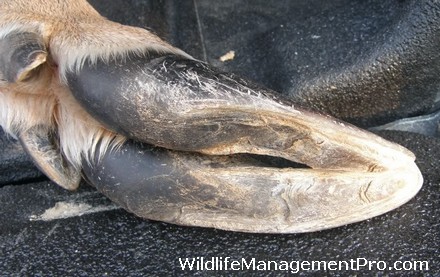There have been a number of times when hunters and landowners have encountered deer with long hooves. White-tailed deer are candidates for a variety of ailments, but foundering in deer can happen for a variety of reasons. In fact, deer with longer than normal hooves is not uncommon at all. From what I have seen through the years of deer hunting and management is that foundering can result from several factors.
Ranches out in West Texas or game ranches that feed lots of corn tend to produce deer with hoof problems. Also, years with drought or even those with especially high temperatures and high winds tend to dry out the land. Foundering often occurs purely because grain intake is too high for whitetail deer. Deer that live solely at spin-cast feeders will consume too much corn. This is especially common when natural foods are in low availability. A deer’s diet should consist primarily of forbs and browse , but these foods can become very limited in areas with high deer densities or during extreme dry periods.

But a diet high in grain is not the only reason deer can grow long hooves. I have also seen supplemental fed deer on protein pellets suffer issues with a feed that is too low in fiber, or a feed with too much grain as the main ingredient. Whitetail deer much more than just protein. They need carbs and fats and fiber as well. Anytime a deer’s diet includes a high percentage of manufactured feeds or small grains problems can develop.
I have seen ranches that feed a free-choice mix 50 percent protein and 50 percent corn have deer issues during good times as well as droughts. It seems that anytime deer are forced to live primarily off of feed, such as when deer numbers are too high for a property, or when the feed is becoming a large part the deer diet, problems can arise. Foundering in deer is one of those problems. It can even be an urban deer management issue because of homeowners feeding deer lots of grain, usually corn.
It seems to me that most hoof problems tend to come in times of stress when pasture are not green. It can happen to any deer at any time. People that raise breeder deer or have penned deer are more aware of dietary needs. Pen deer typically will not have long hoof issues if the feeds are high fiber, where fiber content is close to or more than protein on a percentage basis. Some pen deer will even have access to browse or limited amounts of good alfalfa, which can serve as the necessary fiber component.
Though foundering is most often associated with deer living under stressful situations with less than optimal nutrition, I have seen deer with long hooves come from properties there were well managed during relatively good environmental conditions. It’s rare, but I have seen it a time or two. Individual deer can have issues that arise from personal stress or other illnesses, so foundering in specific deer can happen even when times are good and the deer population is in great shape.
I HAVE HAD DEER WITH HOOVES ABOUT 8 INCHES LONG AND CURVED UP IN A SKI END PROFILE. I HAVE BEEN REPEATEDLY TOLD THAT THIS WAS AN UNKNOWN MINERAL EATING PROBLEM. THE ONE THAT I HAVE NOW IS EATING BARK OFF A 50 YEAR OLD WHITE PINE—-NO NOT THE LICHEN BUT THE HARD DRY BARK AND THIS ONE IS THE ONLY ONE AND SOME WHAT AGGRESSIVE, COMING RIGHT UP TO ME . SHE ALSO HAS BULGES ON EACH SIDE OF HER JAWS, WOULD THIS BE AN INTERNAL FOUNDERING TYPE OF A GROWTH.—-JUST CONCERBED—DON
We have a foundering deer. He has a hard time walking. Seems to be losing muscle mass in hind quarters. I feel bad for him
We have a foundering deer. He has trouble walking. His hind quarters are losing muscle mass